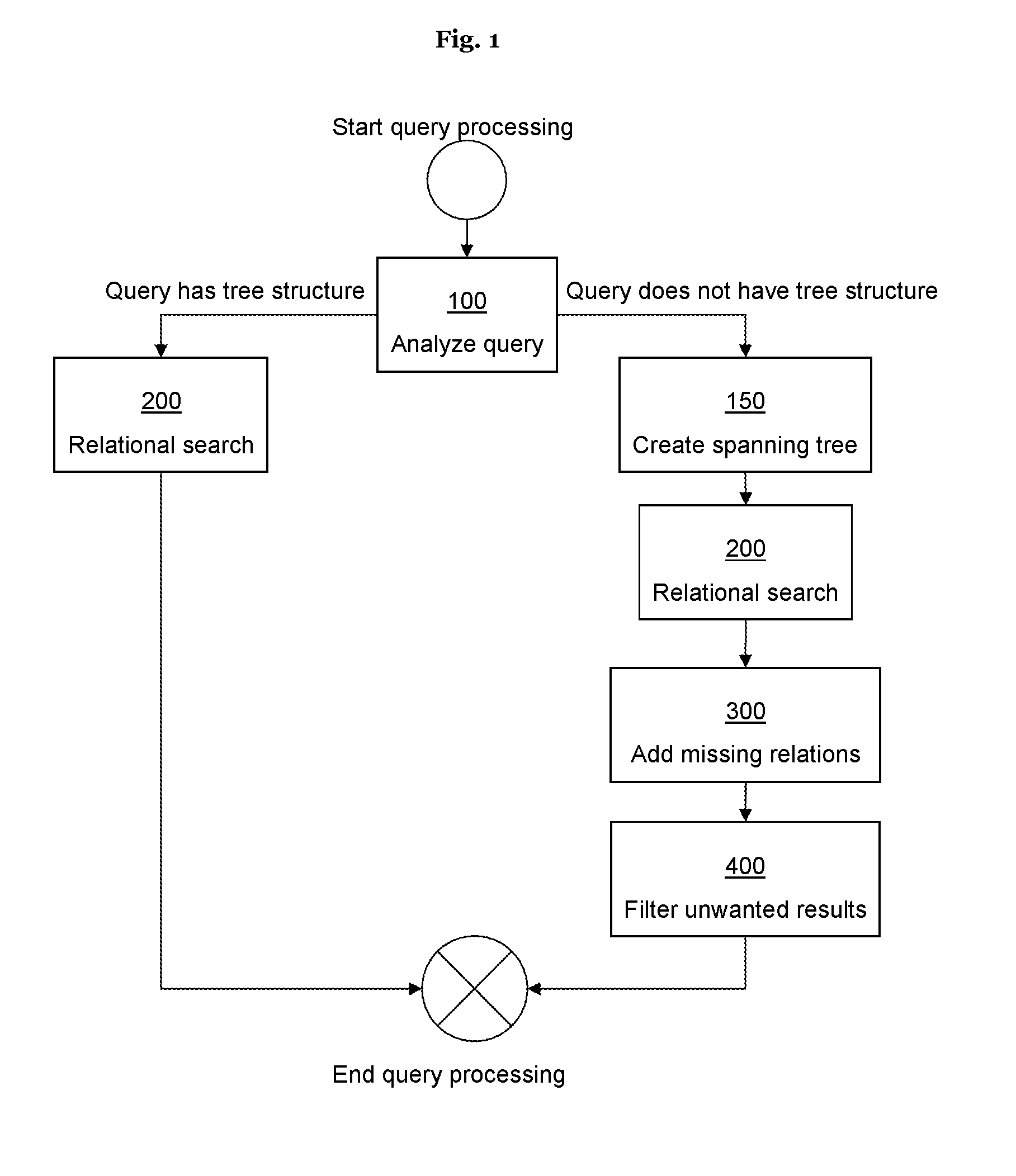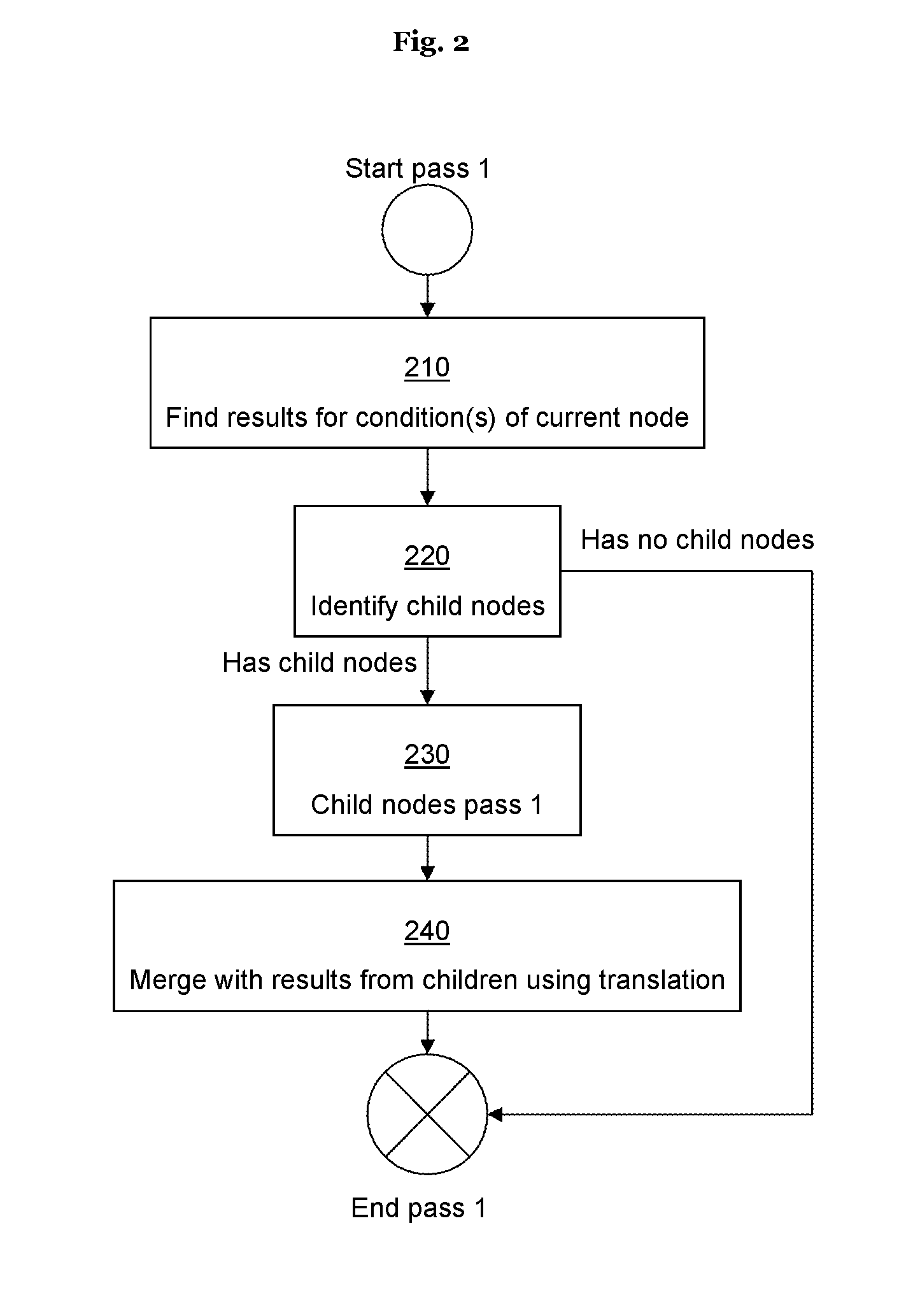Method of processing relational queries in a database system and corresponding database system
Active Publication Date: 2014-01-09
SOFTWARE AG
View PDF49 Cites 36 Cited by
- Summary
- Abstract
- Description
- Claims
- Application Information
AI Technical Summary
Benefits of technology
[0022]Translation allows converting results from query conditions across relationships defined in the query, making them easily comparable and therefore searchable. Importantly, the translation data structures are kept in memory of the database system and only describe which object is related to which other object. Preferably, the translation data structures utilize primitive and compact identifiers and space efficient lookup techniques, such as binary search. Because no object data is kept in memory (note that the corresponding index structures are stored in a storage device of the database system), the translation structure is much smaller than the on-disk index in many scenarios.
[0023]In summary, certain example embodiments advantageously combine the advantages of storage devices (e.g. a hard disk of the underlying computer system, or any other type of permanent storage) and memory (i.e. fast memory, such as a random access memory (RAM) of the underlying computer system) while at the same time avoiding the disadvantages of both types of storage/memory. As the person skilled in the art of computer science will appreciate, the advantage of
Problems solved by technology
Besides simple queries involving search conditions directed only to one type of object (i.e. to one single database table), more complex queries oftentimes involve multiple objects having relations defined therebetween.
As a result, traditional relational databases typically suffer from the relatively slow disk storage access for processing queries to the database.
However, because following relations in a query typically results in random access to the database tables, this strategy performs poorly on larger databases with many small rows.
Most vendors of such databases do not offer any support for relational queries at all.
This approach, however, is limited to scenarios with a small and fixed set of conceivable relational queries and is hardly practical in more complex scenarios.
However, this approach requires large quantities of memory, which greatly limits the scalability do to the hardware limitations in modern computer systems.
While RDBMS are generally able to perform complex relational queries, there are scenarios in which they deliver poor results.
Under these conditions, the person skilled in the art
Method used
the structure of the environmentally friendly knitted fabric provided by the present invention; figure 2 Flow chart of the yarn wrapping machine for environmentally friendly knitted fabrics and storage devices; image 3 Is the parameter map of the yarn covering machine
View moreImage
Smart Image Click on the blue labels to locate them in the text.
Smart ImageViewing Examples
Examples
Experimental program
Comparison scheme
Effect test
 Login to View More
Login to View More PUM
 Login to View More
Login to View More Abstract
Certain example embodiments concern a computer-implemented method of processing a relational query in a database system. The relational query addresses a plurality of data objects linked by one or more relationships. For each data object addressed by the relational query, at least one result is computed in accordance with at least one index structure, with the index structure being stored in a storage device of the database system. The results computed are merged in accordance with at least one translation data structure to produce a final result of the relational query, with the translation data structure representing the one or more relationships between the data objects and being stored in a memory of the database system.
Description
1. TECHNICAL FIELD[0001]Certain example embodiments of the present invention relate to a method of processing relational queries in a database system, as well as to a corresponding database system.2. BACKGROUND AND SUMMARY[0002]Nowadays, data-intensive computer systems typically store their data in databases and database systems are provided which allow storing the data into the database, as well as accessing the stored data.[0003]Accessing data of a database is typically performed by formulating queries in a query language and having the database system process the query. Since complex databases typically store excessive amounts of data, sometimes even millions of individual data objects, many approaches have been developed for increasing the performance of the query processing to allow users to retrieve the searched data as fast as possible.[0004]The most common conventional database systems are so-called relational database management systems (RDBMS). A common language for intera...
Claims
the structure of the environmentally friendly knitted fabric provided by the present invention; figure 2 Flow chart of the yarn wrapping machine for environmentally friendly knitted fabrics and storage devices; image 3 Is the parameter map of the yarn covering machine
Login to View More Application Information
Patent Timeline
 Login to View More
Login to View More IPC IPC(8): G06F17/30
CPCG06F16/2228G06F16/245G06F16/2456G06F16/24561
Inventor POPPITZ, MICHAEL
Owner SOFTWARE AG
Features
- R&D
- Intellectual Property
- Life Sciences
- Materials
- Tech Scout
Why Patsnap Eureka
- Unparalleled Data Quality
- Higher Quality Content
- 60% Fewer Hallucinations
Social media
Patsnap Eureka Blog
Learn More Browse by: Latest US Patents, China's latest patents, Technical Efficacy Thesaurus, Application Domain, Technology Topic, Popular Technical Reports.
© 2025 PatSnap. All rights reserved.Legal|Privacy policy|Modern Slavery Act Transparency Statement|Sitemap|About US| Contact US: help@patsnap.com



